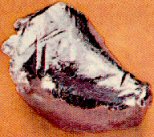 Discovery Information Discovery Information |
| Who: Carlo Perrier,
Emillo Segre
|
| When: 1937 |
| Where: Italy |
|
 Name Origin Name Origin |
| Greek: technetos (artificial). |
|
 Sources Sources |
| Made first by bombarding molybdenum with
deuterons
(heavy hydrogen) in a cyclotron. |
|
 Uses Uses |
| The technetium-99m
isotope
serves as a
radiation
source in medicine where it is used to locate tumours in the spleen, liver, brain, and thyroid. When 99mTc is combined with a tin compound it binds to red blood cells and can therefore be used to map circulatory system disorders. Technetium-99 is used for equipment calibration. |
|
 Notes Notes |
| First artificially created
element
. |
| All
isotopes
of technetium are
radioactive
but the
element
and its
compounds
are extremely rarely found in nature. |
| Most technetium produced on Earth is a by-product of fission of uranium-235 in nuclear reactors and is extracted from nuclear fuel rods. On earth, technetium occurs naturally only in uranium ores as a product of spontaneous fission; the quantities are minute but have been measured. |
| No
isotope
of technetium has a
half-life
longer than 4.2 million years (98Tc), so its detection in red giants in 1952 helped bolster the theory that stars can produce heavier elements. |


 Discovery Information
Discovery Information Name Origin
Name Origin Sources
Sources Uses
Uses Notes
Notes Images
Images